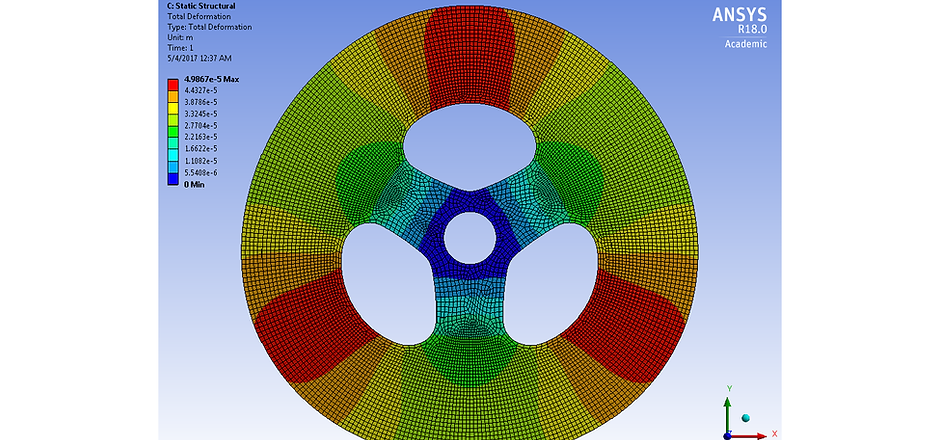LILIA CHAN
FEA ON TESLA TURBINE

ABSTRACT
In this FEA study of the Tesla turbine, which is made in FOMSO, three analyses were conducted: modal, static structural, and fluid dynamics. The modal simulation was looking at the frequencies and mode shapes between a stationary case and a spinning case where all spinning parts were rotating at 26,000 rpm. However, results were inconclusive. The static structural simulation looked at the maximum stress and deformation experienced by the exhaust holes in the disc as it is spun. The simulation shows that they exhaust holes are about to yield at 26,000 rpm. At 50,000 rpm (speed rated for bearings) simulation results show that the discs haven’t deformed enough to stop spinning due to interference with the housing. Therefore, the reason it would stop spinning would probably be the at the failure of the bearings. The fluid dynamics simulation was unsuccessful in modeling all of the air in this turbine configuration, but it was successful in modeling one with a tangential nozzle. The results from that simulation was used to find the optimal disc spacing, which was 0.015 in, 1/5 of the current disc spacing.

STATIC STRUCTURAL
I wanted to verify that the exhaust holes in the discs would yield at speeds higher than 26,000 rpm. If the bearings are to fail after the discs, would the discs even be able to make it up to those speeds (40,000-50,000 rpm) or would they have deformed too much to spin anymore? What is the maximum deformation of the discs at 50,000 rpm?
In this analysis one disc was modeled to determine the stress and deformation of the exhaust holes. The material was assigned as 304 Stainless Steel. The disc for the static structural analysis was meshed with 1 mm elements and ANSYS automatically used hexahedrons. A cylindrical support was applied to the surface of the center hole, where it was fixed radially, axially, and tangentially. A rotational velocity of 26,000 rpm (2722.7 rad/s) was applied to the entire body with a step end time at 1 second. For the 50,000 rpm test the only parameter that changed was the rotational velocity magnitude.
When 26,000 rpm (2722.7 rad/s) was applied to the disc the maximum stress was 196.23 MPa and the yield strength of 304 Stainless Steel is 206.8 MPa. When 50,000 rpm was applied (5236 rad/s) the maximum stress was 725.7 MPa. The maximum deformation of the disc when it is spun at 50,000 rpm (5236 rad/s) is about 0.05 mm or 0.002 in from the origin, which can be seen in Figure 20. This means that at most the diameter increases by 0.1 mm or 0.004 in. This deformation isn’t enough to interfere with the housing because the distance between the discs and the housing is 0.64 mm or 0.025 in. Therefore, even at the speed where the bearings begin to fail, the discs wouldn’t have deformed enough to stop them from spinning.
